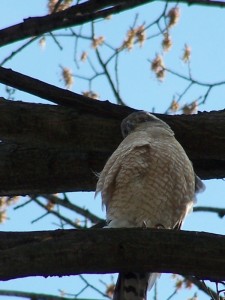Even though it is winter, even though January has a rep for being bleak and stark in Chicago, there’s still beauty to be experienced. Go out and grab you some organic PEACE!
I wrote this Sunday morning at Thatcher. Communing in nature has become one of my spiritual practices :
Koan #7
Frozen River
Silence in the glen
Winter stillness
The rare peep of an unseen bird
Clumps of snow drip
from bare gray branches,
soft thuds onto the ground.
Blue glitter,
a million prisms of light
bless the banks, decay of logs
the ground sculpted into rounds and slopes
by hours of wind and river tongue lashings.
The DesPlaines has frozen —
Time in hibernation,
Spring arrested and Summer’s bubbly frolic
soothed into a cold lullaby
beneath blankets of fleecy white powder.
Delicious hush, how healing you are!
I want to show my son
the land the way it really is,
naked beauty, precious pale sunlight,
the deep sacred silences
no hand-made temple or church can surpass —
this is the open sky, the vault of heaven
the original cathedral.
Too many cars drive past,
one every minute,
speeding to brunches or Sunday services,
rushing on the frozen crunch of road.
But I don’t mind —
more silence for me,
unashamed of my greed,
drinking beauty like a dying woman
as the feathered tips of treetops
brush the morning chill.
Koan # 8
Hint of egret wingspan flapping
behind the tangled jumble
of gray winter branches.
Koan #9
Rush
I hate the rush of days,
man-made hours,
boxes I am trapped inside.
I push against the walls
only to break through
to another box.
Schedules, deadlines,
start times, end times,
school bells, radio alarms,
buzzers, timers, beepers,
cell phones, online bids —
Enough!
Where is the deep time?
The sun moving westward in the sky?
Shadows of trees growing longer?
The moment suspended,
like a dust mote hanging in sunlight,
the slow growing of grass seedlings?
The halted flow of river
beneath the ice?
Where is the joy
of climbing snow heaps
falling, rolling, tumbling
until the laughter and ice streak
your face and there is nothing left
but the pleasure of returning
inside to a hot mug of cocoa
and damp socks drying on the radiator?
I rail against the boxes
we have made
and claw the pages of every schedule
and run, a free woman, to the frozen Palos hills
where time is kept in drips and ice crystals
forming in the winter sun.
– M.G.B.

